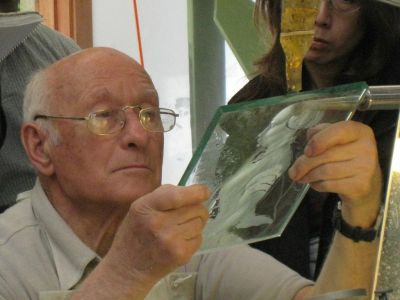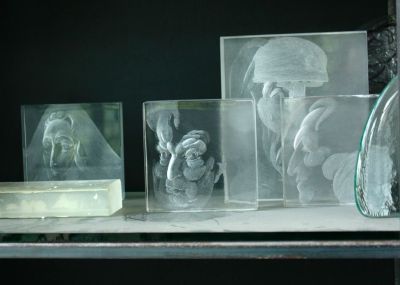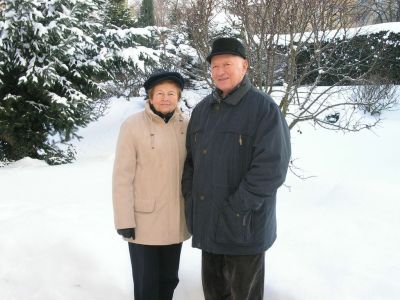 “Every genuine creation is poetry. We do not create what we see, rather what we know and what we think and feel.”—Jiri Harcuba
“Every genuine creation is poetry. We do not create what we see, rather what we know and what we think and feel.”—Jiri Harcuba
Jiri Harcuba, the world-renowned and highly respected artist and master engraver also recognized in the field of coin and medal design, passed away from complications with pneumonia on the morning of July 26, 2013. Born on December 6, 1928 in the glassmaking village of Harrachov (in what is now the Czech Republic), Harcuba dedicated much of his life to teaching the world over and inspired countless people to find their own creative voices. I was introduced to engraving through a course I took with Harcuba at Pilchuck in 2003, and, as this became my primary technique of working with glass, he would go on to be my mentor. We co-taught a number of classes in engraving, the last one at The Corning Museum of Glass in 2012.
Harcuba was in love with life and lived it to it’s fullest with boundless energy and a most gracious spirit. He understood life as poem and found beauty in even the smallest and most overlooked things. He felt lucky to live in his own world and deal with beautiful ideas. He had a certain poetic way of speaking that perfectly expressed the beauty he saw. His words were simple but well considered and even the smallest of statements could inspire one for a lifetime. He was fascinated by phenomenon that couldn’t be explained because he liked the “secrets” of the universe. Often, he would speak of “The art of life,” which he said was “Our perceptions of the secrets [of the world] around and inside us. It is so simple and easy but finding the secret is a lifetime job and the essence of all.”
 With his focus on the expressive possibilities of engraving on glass, Harcuba redefined what was possible in the form.
With his focus on the expressive possibilities of engraving on glass, Harcuba redefined what was possible in the form.
He loved philosophy, poetry, classical music and called people such as Beethoven, Plato, Kafka and Comenius his closest friends. He would engrave their portraits and reflect on their character rather than their likeness. It was with this approach to engraving that Harcuba redefined the field, a dwindling ancient craft that has traditionally been practiced only by masters in a very strict and methodical way. The freedom of expression that he accomplished in his engravings challenged the traditions of craft and brought it from a classical technique to a contemporary form of artistic expression relevant in the 21st century. Because of his approach and prolific teaching that anyone can be an engraver, young people have started to become interested and there is slowly but surely a revival of the practice.
 Jiri Harcuba with April Surgent.
Jiri Harcuba with April Surgent.
Later in life Harcuba became passionate about Wabi-sabi, the Japanese aesthetic of imperfection along with Zen Buddhism. He would explain that “with Wabi-sabi we discover the essence of creativity where we can enter an everlasting dialogue with ourselves.” In the nature of Wabi-sabi, Harcuba was able to capture the essence of a person in just a few sculptural, expressive cuts of the wheel. The most interesting thing to him was the expression that each mark of the wheel made, the ‘traces of ourselves”.
In class, students would find themselves learning about life, art, philosophy and love in place of lessons specific to the detailed techniques of fine engraving. He lived by example rather than by lesson and considered himself not only a lifetime student, but a student of life. He strongly believed that everybody is the teacher of everybody, and, when he taught, he felt he was both a teacher and student. He would argue that it is not necessary to spend years as an apprentice to make a beautiful engraving and encouraged his students to be free while searching for their creative voice and to value imperfection along the way, and not to be oppressed by expectation.
Having 75 years of practice, Harcuba was by all means a master artist. He was introduced to glass when he was just ten years old. Assisting his father, who was a brilliant glass cutter, by applying polishing compounds to the wheels for him. He would tell stories of watching his friends play soccer from the window while he was stuck inside behind his father’s lathe applying compound to his polishing wheels. In 1942, when he was 14, he followed in his father’s footsteps and started an apprenticeship as an engraver at the Harrachov glass factory. In 1945-48 he studied at the Specialized School of Glassmaking and then went on to study glyptic sculpture at the Academy of Applied Arts in Prague.
Harcuba taught at the Academy of Applied Arts in Prague for 10 years from 1961 – 1971 until he was removed from the position and jailed as a political prisoner during a period of intense political upheaval. He had designed a medal that opposed the Soviet invasion of Prague in 1968. Though he was freed after several months, he pursued a career as an independent artist and did not go back to the Academy until 1990, when he was reinstated by president, Vaclav Havel. From 1991 to 1994 he was the chancellor of the Academy.
 Jiri Harcuba designed the 5-koruna coin, in circulation as currency in the Czech Republic.
Jiri Harcuba designed the 5-koruna coin, in circulation as currency in the Czech Republic.
From 1994 -2013, Harcuba practiced as a full-time artist, taught and designed coins and medals. He focused on making portraits that captured the soul of a person and was always open to new ideas and ways of approach. He taught workshops all over the world at schools around the world, including in the U.S., Japan, Scotland, Turkey, and the Czech Republic. For 15 consecutive years he taught at the Corning Studio, his last year in 2012. Among many notable achievements in his medal and coin pieces, he designed the Czech currency, the 5-koruna coin.
 Jiri Harcuba with his wife, Zdena.
Jiri Harcuba with his wife, Zdena.
Mr. Harcuba loved and was loved by so many people. He lived an extraordinary life and made extraordinary art. He leaves behind his beautiful wife Zdena, two children, grandchildren and an entire world of friends, students and admirers. He left us with traces of himself and insights on life that will inspire generations to come. We feel fortunate to have known and loved such a beautiful person. I imagine he left us with this thought, which he frequently shared with his students, on his mind:
“To me, living in one’s own world is a gorgeous adventure. Life is beautiful and our own life is the greatest gift that we have got! Lets enjoy it! Be excited! Smile! Love! Don’t worry – Be happy as I am! ”
—April Surgent


